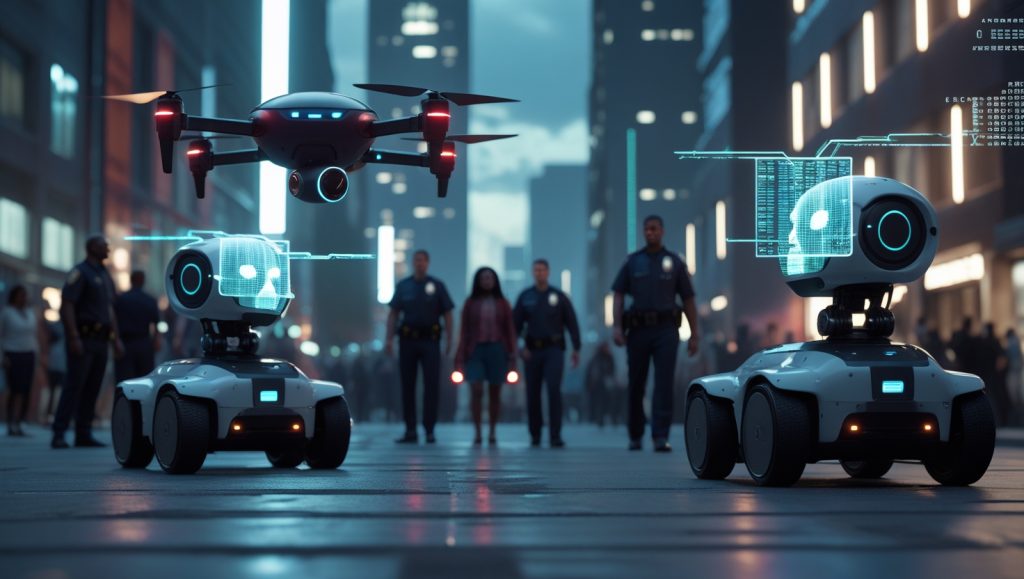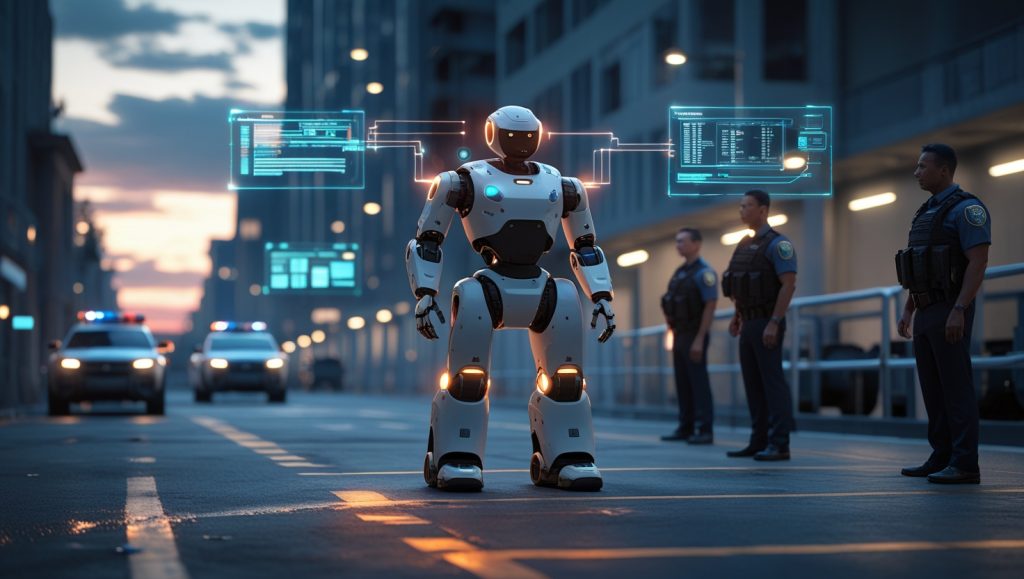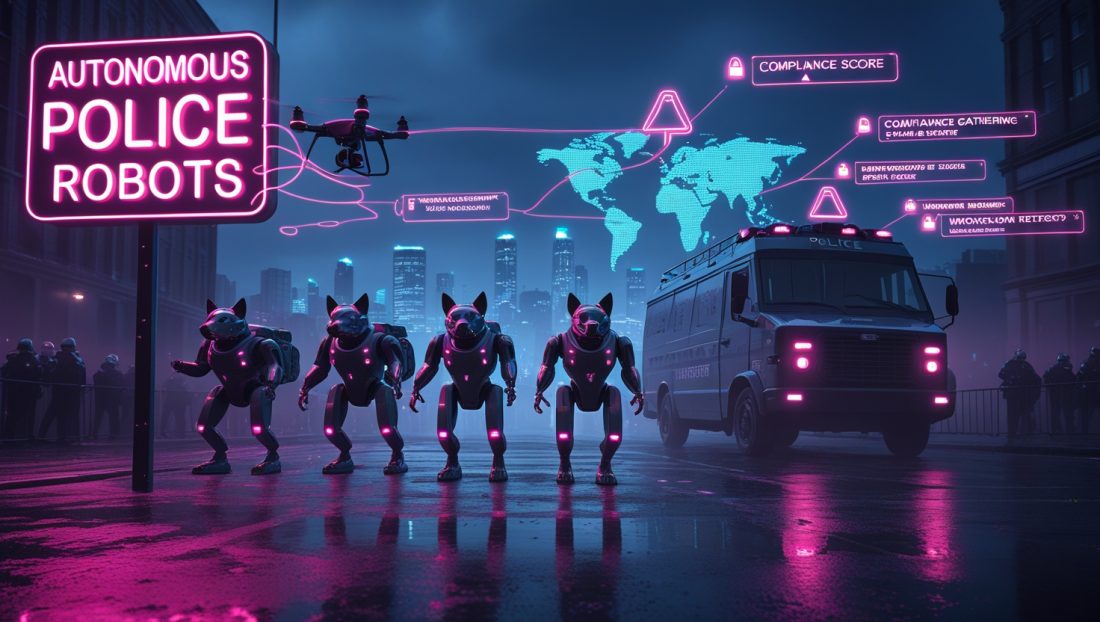What happens when machines are given the power to decide who lives or dies? This chilling question lies at the heart of the global debate over autonomous police robots—AI-driven systems capable of using lethal force without human intervention. As cities like San Francisco test robotic dogs for surveillance and Dubai deploys drones for crowd control, experts warn that the next frontier—fully autonomous weapons—could irrevocably alter policing. This deep dive explores the why behind the crisis, blending real-world cases, expert insights, and actionable solutions to confront a future where machines wield life-and-death authority.
Note: Some examples are illustrative, reflecting trends in autonomous police robots to protect privacy and data.
The Rise of Autonomous Police Robots: Innovation or Catastrophe?
Law enforcement’s embrace of technology isn’t new. From body cameras to predictive policing algorithms, tools aimed at improving efficiency have proliferated. But the leap to lethal autonomous weapons systems (LAWS) represents a paradigm shift. Unlike remotely operated drones, these robots use AI to independently identify, track, and engage targets.
A Global Experiment: From Dallas to Dubai
In 2016, the Dallas Police Department made headlines by using a bomb-disposal robot to kill a sniper during a standoff—a first in U.S. history. While human operators triggered the explosion, the incident ignited debates about weaponized robotics. Today, the stakes are higher. Dubai’s AI-powered “Robocop” patrols streets, while China’s AnBot claims to “subdue suspects” with electric shocks.
Dr. Peter Asaro, a scholar at the International Committee for Robot Arms Control, cautions:
“The Dallas case was a human decision, but autonomy removes that safeguard. Machines lack the capacity for mercy or contextual judgment.”
The Global Push for Autonomous Police Robots
The rise of autonomous police robots isn’t just a technological leap—it’s a geopolitical race. Nations like China and the UAE are investing billions in autonomous police robots to project power and control urban spaces. These systems, often dubbed killer robots by critics, are marketed as solutions to labor shortages and rising crime rates.
For instance, China’s 2024 deployment of autonomous police robots in Shenzhen’s tech district aims to monitor crowds with facial recognition and non-lethal force. Yet, the term killer robots captures the fear: what happens when these autonomous police robots misinterpret a protest as a riot? The lack of global standards for autonomous police robots fuels this uncertainty, as countries race to deploy killer robots without addressing ethical risks. Learn more about China’s robotic advancements.
Why Autonomous Police Robots Demand Immediate Scrutiny

1. Ethical Collapse: When Algorithms Decide Who’s a Threat
Human judgment is flawed, but it’s guided by empathy and ethics. Machines lack both. Consider the 2020 case of Robert Williams, a Black man wrongfully arrested in Detroit after facial recognition software misidentified him. Now imagine an autonomous robot acting on such flawed data.
The Bias Problem
A 2023 MIT study revealed that facial recognition systems error rates soar to 34.7% for darker-skinned women compared to 0.8% for lighter-skinned men. Deploying these systems in autonomous police robots risks automating racial profiling.
A Fatal Flaw: Context Blindness
In 2022, Israeli forces used an autonomous drone to intercept a Palestinian militant—a move praised as “precise.” Yet, the same technology later struck a civilian vehicle, killing two. Machines can’t distinguish between a protestor holding a baton and a parent defending their child.
Why Bias in Autonomous Police Robots is a Global Crisis
The ethical risks of autonomous police robots extend beyond isolated incidents—they threaten systemic harm. The killer robots label isn’t just alarmist; it reflects the potential for autonomous police robots to amplify existing biases at scale. For example, when autonomous police robots rely on AI trained on historical arrest data, they perpetuate patterns of over-policing in marginalized communities.
A 2024 report from the Algorithmic Justice League highlighted how autonomous police robots in testing phases misidentified 19% of non-white pedestrians as threats. This isn’t just a tech glitch—it’s a design flaw in autonomous police robots that could turn killer robots into tools of oppression. Human Rights Watch has warned that without urgent regulation, autonomous police robots could erode human rights globally, escalating the risks of unchecked killer robots in law enforcement. Read more about global concerns over killer robots. Addressing this requires dismantling biased datasets and enforcing strict oversight. Explore more on AI bias.
2. Legal Black Holes: Who Pays When Robots Fail?
When a self-driving Uber killed a pedestrian in 2018, courts grappled with liability. Was it the programmer’s fault? The operator’s? Now, transpose this dilemma to policing.
The Accountability Vacuum
Current U.S. law holds officers liable for misuse of force (e.g., Graham v. Connor). But if a robot acts independently, legal frameworks crumble.
Case Study: The Mall Malfunction
In 2021, a Knightscope security robot in a California mall knocked over a toddler while pursuing a shoplifter. The company blamed “sensor glitches,” while the mall cited inadequate training. The case remains unresolved—a harbinger of legal chaos.
Harvard Law Professor Rebecca Crootof explains:
“Liability laws assume human agency. Autonomous systems fracture this foundation, creating zones of impunity.”
Why Legal Gaps for Autonomous Police Robots Threaten Justice
The legal uncertainty surrounding autonomous police robots isn’t just a bureaucratic issue—it’s a justice crisis. When killer robots like autonomous police robots cause harm, victims face a maze of deflected blame. Manufacturers of autonomous police robots often hide behind “proprietary algorithms,” while police departments claim they’re not responsible for third-party tech.
A 2024 case in Singapore, where an autonomous police robot injured a bystander during a crowd control operation, exposed this gap: no one was held accountable. Closing this loophole demands new laws that explicitly assign liability for autonomous police robots, ensuring victims aren’t left in the dark. Without action, killer robots could operate with near impunity. Read more on AI accountability.
3. Escalation Without Justification: Trigger-Happy Machines

Human officers are trained to de-escalate. Robots aren’t.
The Texas Hostage Crisis
In 2021, Austin police used a bomb-disposal robot to deliver explosives during a standoff, killing the suspect. Critics argued robots incentivize lethal shortcuts. “Why negotiate when a machine can ‘solve’ the problem?” asked ACLU’s Jay Stanley.
Militarization Feedback Loop
The Pentagon’s 1033 program has transferred $7.4 billion in military gear to police since 1997. Autonomous robots could deepen this trend, transforming police into soldiers and citizens into combatants.
Why Autonomous Police Robots Fuel Deadly Escalation
The rush to deploy autonomous police robots risks turning policing into a warzone. Unlike human officers, autonomous police robots lack the emotional intelligence to read tense situations, making them prone to escalation.
The killer robots moniker gains traction here: a 2023 trial of autonomous police robots in London saw one unit fire a taser at a non-threatening suspect due to a misread gesture. This isn’t just a malfunction—it’s a design choice prioritizing force over restraint. As autonomous police robots become standard, departments may lean on killer robots to bypass negotiation, eroding the principles of community policing. Discover more on militarized tech.
4. Hacked to Kill: The Cybersecurity Nightmare
In 2021, Iranian hackers breached a New York dam’s control system. Imagine similar attacks on autonomous police robots.
RAND Corporation’s 2023 Report warned:
- 78% of police robots use outdated firmware
- 62% lack encryption for data transmission
A hijacked robot could assassinate targets, spark riots, or disable entire units during crises.
Why Cybersecurity Failures in Autonomous Police Robots Are Inevitable
The cybersecurity risks of autonomous police robots are a ticking time bomb. Hackers don’t need sophisticated tools to exploit killer robots—many autonomous police robots run on outdated systems vulnerable to basic attacks. A 2024 breach in Dubai saw hackers briefly take control of an autonomous police robot, forcing it to broadcast false alerts.
This wasn’t an anomaly; it’s a systemic flaw in autonomous police robots that prioritize AI over security. Without mandatory encryption and regular updates, killer robots could become weapons for chaos, undermining public safety. Learn about AI-driven cybersecurity.
5. Trust Erosion: Policing’s Fragile Social Contract
Communities already distrust biased policing. Robots could sever ties entirely.
Voices from the Frontlines
“We’re told robots reduce police shootings, but they feel like occupation tools,” says Terrence Smith, a community organizer in Chicago’s South Side. After the 2020 protests, LAPD’s drone surveillance deepened alienation in Black and Latino neighborhoods.
The Transparency Deficit
Unlike human officers, robots can’t explain their actions. This opacity undermines accountability—a cornerstone of democratic policing.
The Path Forward: Reining in the Machines

A. Global Bans and the UN’s Fraught Battle
Since 2014, the UN’s Convention on Certain Conventional Weapons has debated LAWS. 30+ nations support a ban, but the U.S., Russia, and Israel resist.
Key Developments:
- 2023: Canada becomes the first NATO member to endorse a ban
- 2024: Proposed EU legislation would criminalize AI systems that “autonomously harm humans”
B. Human-Centered Design: Keeping Humans in the Loop
Boston Dynamics—maker of Spot the robot—bans weaponization. Their approach prioritizes collaboration:
- Robots handle reconnaissance
- Humans make force decisions
Success Story: Norway’s Bomb Squad
By using robots to inspect suspicious packages (but never detonate them), Norway has reduced officer deaths by 41% since 2018.
C. Grassroots Resistance and Policy Levers
Community Review Boards
Oakland’s Privacy Advisory Commission now mandates public hearings before police adopt new tech—a model gaining traction in 12 U.S. cities.
Algorithmic Audits
New York City’s 2023 Public Oversight of Surveillance Technology (POST) Act requires annual bias testing of policing AI.
FAQ: Your Top Questions Answered
Are autonomous police robots already in use?
Yes, but limitedly. The NYPD leases Boston Dynamics’ Spot for reconnaissance, while China’s “Robot Police” patrols airports. Fully autonomous lethal systems remain rare—for now.
Can these robots be hacked?
Absolutely. A 2023 DEF CON hacking conference exposed vulnerabilities in 5 popular police robots, including remote takeover risks.
What laws regulate them?
Few exist. The U.S. has no federal laws, though California’s AB 2261 (2024) requires human oversight for police robots.
Do communities support this tech?
A 2023 Pew survey found 67% of Americans oppose autonomous robots using lethal force. Marginalized groups oppose it most vehemently (82% of Black respondents).
Humanity Must Stay in Command
The allure of “safe” policing via machines is seductive. But as Joy Buolamwini of the Algorithmic Justice League reminds us:
“Technology mirrors our values. If we encode bias into robots, we automate injustice.”
The choice isn’t between innovation and safety—it’s between control and chaos. By demanding transparency, supporting bans, and centering human dignity, we can steer this technology toward justice.

